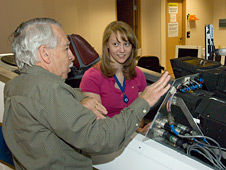EDWARDS, Calif. – Kerianne Hobbs’ first memory of NASA was a family visit to NASA’s Johnson Space Center when she was six. That trip left the Spring, Texas, native with a love of space. Thus Hobbs jumped at the opportunity to participate in NASA’s Cooperative Education Program.
 Hobbs receives some information about the flight simuluator. (NASA photo) Hobbs is an aerospace engineering student at Embry-Riddle Aeronautical University in Prescott, Ariz. She learned about NASA’s co-op program at the university’s career fair. She applied, hoping for a summer internship and was awarded one that keeps her employed at NASA’s Dryden Flight Research Center from January through August 2009.
Hobbs receives some information about the flight simuluator. (NASA photo) Hobbs is an aerospace engineering student at Embry-Riddle Aeronautical University in Prescott, Ariz. She learned about NASA’s co-op program at the university’s career fair. She applied, hoping for a summer internship and was awarded one that keeps her employed at NASA’s Dryden Flight Research Center from January through August 2009.
The center, located on Edwards Air Force Base in California’s Mojave Desert, is known for its flight research and as an alternate space shuttle landing site. It is the perfect mix for Hobbs.
Assigned to Dryden’s Simulation Engineering Branch, Hobbs is tasked with the development of a simulation program for aircraft. The program will build a script, or list of parameters defined by an engineer, that will be fed into computer simulation software. This program will be used as a tool for modeling the behavior of an aircraft during a predetermined set of flight conditions.
“It is important to test something in a safe environment before actually taking it to flight,” said Hobbs.
In addition to developing the simulation program, Hobbs is responsible for designing and organizing the fabrication of a panel in an F-18 simulator cockpit that will mimic a cockpit update in an actual NASA Dryden F-18 research aircraft..
Hobbs is also assigned to build a power adapter assembly to support the loading of data into an F-18 mission simulator. This powerbox will replace outdated hardware currently in use.
“Every person is proud to work at NASA. It doesn’t matter if their work is in human resources or engineering,” said Hobbs of her experience at Dryden.
“Dryden is in the middle of nowhere, but its Mojave Desert location is in the forefront of aviation,” added Hobbs, who hopes to work in a space-related engineering position after her May 2011 graduation. “Much of the cutting edge aerospace industry is in California’s Antelope Valley.”
Hobbs, an editor and staff writer for Horizons, Embry-Riddle’s student newspaper, loves art and creative writing as much as space.
“Engineering blends the love of art and the love of science,” added Hobbs.
– end –
text-only version of this release
To receive status reports and news releases issued from the Dryden Newsroom electronically, send a blank e-mail message to dfrc-subscribe@newsletters.nasa.gov. To unsubscribe, send a blank e-mail message to dfrc-unsubscribe@newsletters.nasa.gov. The system will confirm your request via e-mail.
Dryden Flight Research Center
P.O. Box 273
Edwards, California 93523
Phone 661-276-3449
FAX 661-276-3566
Beth Hagenauer
NASA Dryden Flight Research Center
661-276-7960
beth.hagenauer@nasa.gov




























